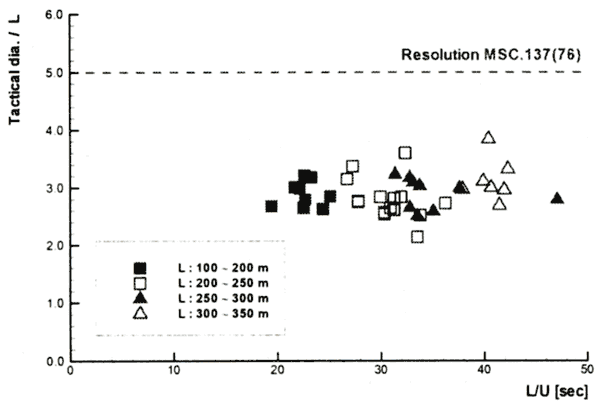|
2.4 Sea-trial Results
Fig. 6 and Fig. 7 respectively show the turning ability indices and yaw-checking and course-keeping ability indices measured from manoeuvring sea-trials.
Fig.6 Turning ability indices from sea-trial.
(a)Advance / L
(b) Tactical diameter / L

If a ship has both port and starboard data, averaged values are used. Dashed lines on the figures are the new IMO resolution MSC 137 (76). In case of advance and tactical diameter, all of the ships satisfy the new resolution with sufficient margin. In case of overshoot angles, the situation is not so good and we can find a few substandard ships which can not satisfy the resolution. Table 3 summarizes the ratio of the substandard ships. What is remarkable is that more than 30% of the ships in group 1 does not satisfy the resolution. Furthermore, the smaller ships have the smaller margin in overshoot angles, except one ship in the group 3. Fig. 8 compares the calculated PKT with the measured advance and tactical diameter. As PKT is increased, both advance and tactical diameter are decreased, but it is not so clear. Fig. 9 compares the calculated KT with the overshoot angles of 10°/10° zigzag test. In case of 1st overshoot angle, it seems to be no relationship between overshoot angle and KT. But the 2nd overshoot angle shows increasing tendency due to the increase of KT.
Table 4 Ratio of substandard ships
Length
[m] |
10°/ 10°Z
1st OVS. |
10°/ 10°Z
2nd OVS. |
20°/ 20°Z
1st OVS. |
| 100 〜 200 |
3/9 (33%) |
1/9 (11%) |
0/9 (0%) |
| 200 〜 250 |
0/15 (0%) |
0/15 (0%) |
0/15 (0%) |
| 250 〜 300 |
0/9 (0%) |
0/9 (0%) |
1/9 (11%) |
| 300 〜 350 |
0/7 (0%) |
0/7 (0%) |
0/7 (0%) |
|
Fig.7 Yaw-checking and course-keeping abilities indices from sea-trial.
(a)1st overshoot angles of 10°/10°zigzag test
(b)2nd overshoot angles of 10°/10°zigzag test
(c)1st overshoot angles of 20°/20°zigzag test
|